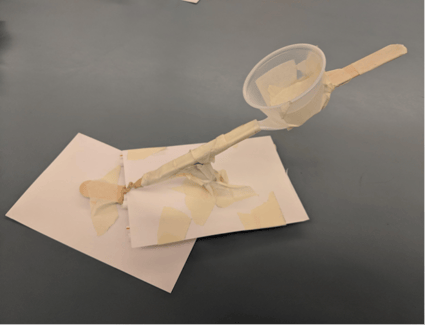December 16, 2024 k-2-measurement-and-data, 3-5-measurement-and-data, 6-8-the-number-system, other-seasonal
FREE Printable STEAM Lessons: Snowball Catapult
By: Jeff Todd
I'm always looking for STEAM lessons for the math classroom. Luckily, inspiration for fresh and fun STEAM projects seems to be popping up all around me. Last year, while working with the intervention students at my school, I incorporated winter-themed STEAM activities into one of my math lessons. With all the positive feedback I got from students, I decided to build out the activity into a 2-day Snowball Catapult STEAM Lesson for grades 1–6. In this article, you'll get access to the FREE printables I created for this fun STEAM lesson.

The download for this post is a complete Science, Technology, Engineering, Arts, and Math (STEAM) lesson plan so you can quickly get it up and running in your classroom. Included you'll find information about materials, classroom set-up, procedures, catapult design constraints, data collection, and example videos. Plus, the lesson plan download also comes with instructions and reflection sheets for students.
Before we explore the Snowball Catapult STEAM Lesson, I want to share with you some tips and observations that I have gathered as I have been implementing STEAM activities with my students.
A Fun Winter STEAM Lesson for Math Students
Overview
Throwing a snowball is a normal part of childhood for those of us who live in the northern part of the United States. Even if you are from a warmer climate, your students will be totally engaged in this activity, as it is just so much fun for them!
With the Snowball Catapult STEAM Lesson, students will engage in Science, Technology, Engineering, Arts, and Mathematics activities. Students will team up to create catapults that can launch “snowballs” made from ping pong balls or Styrofoam balls. After subjecting the constructed catapults to a launch test, teams will have the opportunity to rebuild or reinforce their catapults before a second test.
For this math-focused STEAM lesson, you should plan to spend two class periods.
Requirements
- Teams must build a catapult that can launch a snowball as far as possible using only the materials provided.
- Teams must show a design of their catapult before they begin construction.
- All catapults must lie flat on the table/launchpad.
- Teams may tape their catapult to the table, but they may not hold it in place while launching.
- Catapult must not hang off the end of the table.
- When testing, teams will launch the approved “snowball” five times and record results.
The download for this post is a complete lesson plan so you can quickly get it up and running in your classroom. Included you'll find information about materials, classroom set-up, procedures, catapult design constraints, data collection, and example videos. Plus, the lesson plan download also comes with instructions and reflection sheets for students.
Connections
STEAM activities for elementary students connect with many areas of the curriculum. There are some great science and math tie-ins for this snowball catapult activity, as well as opportunities for students to use their sketching skills, which also makes this a nice connection to the art curriculum. Here are some of the connections you can use for this lesson.
Science, Technology, Engineering
There are many areas within the Force and Motion Disciplinary Core Ideas of the Next Gen Science Standards that you can tie into this STEAM Activity.
- The strength and direction of pushes and pulls
- Observe and measure the effects of force on objects
- Effects of the mass of an object on its motion
- Kinetic and potential energy
- Analyze data from tests of an object or tool
- Developing, testing, and modifying designs
- Consider how the materials provided create limitations and opportunities for the project
Art
Seeing the development of a catapult of an artistic endeavor allows us to use these art standards to help students see how engineering design and the arts are intimately related. The National Art Standards include:
- Generating and conceptualizing artistic ideas and work
- Organizing and developing artistic ideas and work
- Refining and complete artistic work
- Developing and refining artistic techniques and work for presentation
- Conveying meaning through the presentation of artistic work
Math
There are three areas where students are able to tie this activity to their math knowledge. The first is in measuring the distance their snowball travels. The second is in data analysis. This can go as deep as students can handle, from simply creating line plots to calculating an average or finding a range. The third area is more appropriate for upper elementary students, where you can discuss the angle of the catapult’s launching arm and how it affects the distance the snowball travels.
Procedure
DAY 1
5 minutes—Welcome students and organize them into groups of three or four
5 minutes—Introduce the activity. Review the constraints and the materials provided
10–15 minutes—Students use the Snowball Catapult Directions Sheet (included in the download) to create their design
15–20 minutes—After a teacher approves the design, the students build the catapult
15 minutes—Testing catapults, recording data, and creating line plots
5 minutes—Cleanup
DAY 2
10 minutes—Share results of the previous day, create a whole class line plot on board or using a projector
10–15 minutes—Students use the Reflection and Redesign Sheet (included in the download) to propose modifications to their catapult
15–20 minutes—After a teacher reviews the re-design, the students modify or rebuild the catapult
15 minutes—Testing catapults, recording data, creating line plots and reflection
5 minutes—Cleanup
Final Comments
This Snowball Catapult STEAM Lesson is one of the most engaging STEAM activities I have ever done. Students loved it! In addition, you probably have most of the materials you need in your supply closet, or you will find them cheaply and easily available from a local store, except for ping pong balls. The free downloads for this lesson will keep you on track and help students document their designs and their thinking.
Here are some close-up photos and videos of students’ catapults. The videos show some of the designs in action. The designs below are what our Grade 5 and 6 students built without us giving them examples.






